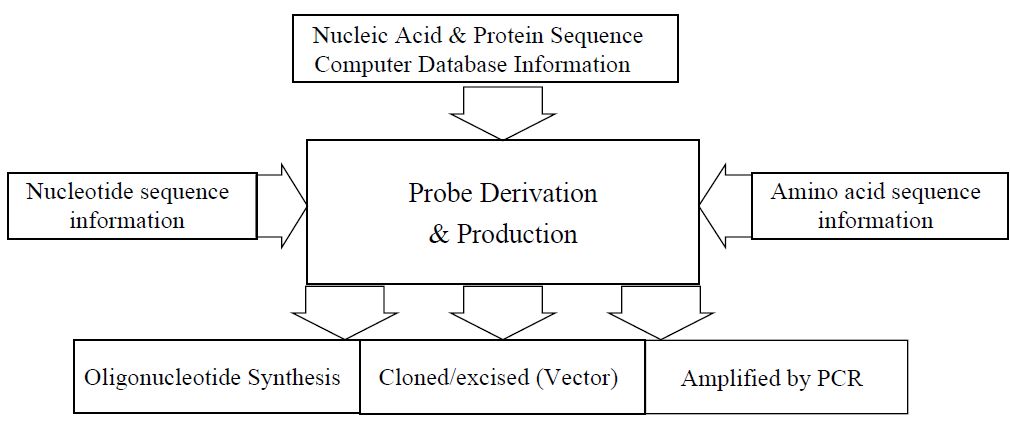


 النبات
النبات
 الحيوان
الحيوان
 الأحياء المجهرية
الأحياء المجهرية
 علم الأمراض
علم الأمراض
 التقانة الإحيائية
التقانة الإحيائية
 التقنية الحيوية المكروبية
التقنية الحيوية المكروبية
 التقنية الحياتية النانوية
التقنية الحياتية النانوية
 علم الأجنة
علم الأجنة
 الأحياء الجزيئي
الأحياء الجزيئي
 علم وظائف الأعضاء
علم وظائف الأعضاء
 الغدد
الغدد
 المضادات الحيوية
المضادات الحيوية|
Read More
Date: 7-4-2021
Date: 20-12-2015
Date: 25-12-2015
|
Gene Probe Derivation
The availability of a gene probe is essential in many molecular biology techniques, yet in many cases is one of the most difficult steps (Figure 1).
The information needed to produce a gene probe may come from many sources, but with the development and sophistication of genetic databases this is usually one of the first stages. There are a number of genetic databases throughout the world and it is possible to search these over the internet and identify particular sequences relating to a specific gene or protein. In some cases it is possible to use related proteins from the same gene family to gain information on the most useful DNA sequence.
Similar proteins or DNA sequences but from different species may also provide a starting point with which to produce a so-called heterologous gene probe. Although in some cases probes have already been produced and cloned, it is possible, armed with a DNA sequence from a DNA

Figure 1. Alternative strategies for designing and producing a gene probe.
database, to synthesise chemically a single-stranded oligonucleotide probe. This is usually undertaken by computer-controlled gene synthesisers which link dNTPs together based on a desired sequence. It is essential to carry out certain checks before probe production to determine that the probe is unique, is not able to self-anneal or is self-complementary, all of which may compromise its use.
Where little DNA information is available to prepare a gene probe, it is possible in some cases to use the knowledge gained from analysis of the corresponding protein. Thus it is possible to isolate and purify proteins and sequence part of the N-terminal end of the protein. From our knowledge of the genetic code, it is possible to predict the various DNA sequences that could code for the protein and then synthesise appropriate oligonucleotide sequences chemically. Due to the degeneracy of the genetic code, most amino acids are coded for by more than one codon, hence there will be more than one possible nucleotide sequence which could code for a given polypeptide. The longer the polypeptide, the greater is the number of possible oligonucleotides which must be synthesised.
Fortunately, there is no need to synthesise a sequence longer than about 20 bases, since this should hybridise efficiently with any complementary sequences and should be specific for one gene. Ideally, a section of the protein should be chosen which contains as many tryptophan and methionine residues as possible, since these have unique codons and there will therefore be fewer possible base sequences which could
code for that part of the protein. The synthetic oligonucleotides can then be used as probes in a number of molecular biology methods.



|
|
|
|
دراسة: إجراء واحد لتقليل المخاطر الجينية للوفاة المبكرة
|
|
|
|
|
|
|
"الملح والماء" يمهدان الطريق لأجهزة كمبيوتر تحاكي الدماغ البشري
|
|
|
|
|
|
بالصور: عند زيارته لمعهد نور الإمام الحسين (عليه السلام) للمكفوفين وضعاف البصر في كربلاء.. ممثل المرجعية العليا يقف على الخدمات المقدمة للطلبة والطالبات
|
|
|
|
ممثل المرجعية العليا يؤكد استعداد العتبة الحسينية لتبني إكمال الدراسة الجامعية لشريحة المكفوفين في العراق
|
|
|
|
ممثل المرجعية العليا يؤكد على ضرورة مواكبة التطورات العالمية واستقطاب الكفاءات العراقية لتقديم أفضل الخدمات للمواطنين
|
|
|
|
العتبة الحسينية تستملك قطعة أرض في العاصمة بغداد لإنشاء مستشفى لعلاج الأورام السرطانية ومركز تخصصي للتوحد
|